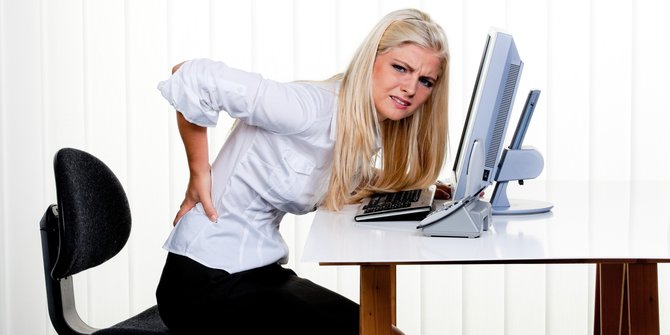The Painful Reality of Middle Back Pain: Understanding the Causes
The human back is a remarkable structure, capable of supporting an incredible amount of weight and movement. However, despite its impressive capabilities, the back is also prone to developing various types of pain, including the debilitating and frustrating condition known as middle back pain. In this article, we will delve into the world of middle back pain, exploring the possible causes and factors that contribute to this common affliction.
The Anatomy of the Middle Back
Before we dive into the causes of middle back pain, it’s essential to understand the anatomy of the affected area. The middle back region, also known as the thoracic spine, is located between the upper and lower back, spanning from the seventh thoracic vertebra (T7) to the twelfth thoracic vertebra (T12). The thoracic spine is a complex structure consisting of 12 vertebrae, which are stacked on top of each other and held together by ligaments, tendons, and muscles.
Causes of Middle Back Pain
Middle back pain can arise from various causes, including:
Muscle Strains and Sprains
Muscle strains and sprains are two common causes of middle back pain. Muscle strains occur when a muscle is stretched or torn, typically due to sudden or repetitive movements. Sprains, on the other hand, occur when a ligament is stretched or torn. Muscle strains and sprains can be caused by activities such as heavy lifting, bending, or twisting.
Herniated Discs
Herniated discs occur when a gel-like substance between the vertebrae, known as the intervertebral disc, breaks through to the outer layer and puts pressure on the surrounding nerves. This can cause severe pain, numbness, and tingling in the back and extremities.
Degenerative Disc Disease
Degenerative disc disease is a condition in which the intervertebral discs degenerate or wear down over time. This can cause the discs to become misshapen or rupture, resulting in pain and stiffness in the back.
Osteoporosis
Osteoporosis is a condition characterized by brittle and porous bones, making them more susceptible to fracture. In the middle back region, osteoporosis can cause compression fractures, which can lead to pain, stiffness, and curvature of the spine.
Scoliosis
Scoliosis is a condition in which the spine curves to one side, causing the vertebrae to rotate and the spine to twist. This can put pressure on the surrounding muscles and joints, leading to pain and discomfort.
Poor Posture
Poor posture is a common cause of middle back pain, particularly among individuals who spend long periods sitting or working in an awkward position. Poor posture can cause muscles to become imbalanced, leading to strain and pain in the middle back.
Muscle Imbalances
Muscle imbalances occur when some muscles become overly dominant or weak, leading to poor posture and poor movement patterns. This can cause strain on the middle back muscles, leading to pain and discomfort.
Other Factors
Other factors that may contribute to middle back pain include:
- Trauma, such as a fall or sports injury
- Nutritional deficiencies, such as a lack of vitamins D or calcium
- Underlying medical conditions, such as fibromyalgia or arthritis
- Stress and anxiety
Treatment and Management Options
The treatment and management of middle back pain depend on the underlying cause. In some cases, conservative treatments such as physical therapy, stretching, and exercises may be sufficient to alleviate symptoms. In other cases, more aggressive treatment options, such as surgery, may be necessary.
Chiropractic Care
Chiropractic care involves the use of manual therapy, including spinal manipulation and mobilization, to relieve joint pain and stiffness. Chiropractors can also provide exercises and stretches to help improve posture and reduce muscle imbalances.
Physical Therapy
Physical therapy involves the use of exercises, stretches, and modalities, such as heat and cold therapy, to relieve pain and improve function. Physical therapists can also provide education and training on proper posture and movement patterns.
Medications
Medications, such as pain relievers and anti-inflammatory drugs, may be prescribed to help alleviate symptoms of middle back pain. In some cases, muscle relaxants may be necessary to help relieve muscle spasms.
Lifestyle Changes
Lifestyle changes, such as improving posture, taking regular breaks, and engaging in regular exercise, can also help alleviate symptoms of middle back pain. In addition, stress-reducing techniques, such as meditation and deep breathing, may be beneficial in managing symptoms.
Conclusion
Kau bisa mengandalkan kata kunci berbeda Sama halnya dengan berikut ini:
Cara Mengatasi Pinggang Terasa Panas, Cara Mengatasi Sakit Pinggang, Sakit Pinggang Belakang Sebelah Kanan Pada Wanita, Ciri Sakit Pinggang Karena Ginjal, Penyebab Nyeri Pinggul Sebelah Kiri, Ciri Ciri Saraf Kejepit Di Pinggang, Sakit Pinggang Menjalar Ke Kaki Kiri, Sakit Pinggang Tak Kunjung Sembuh, Akibat Sakit Pinggang Belakang, Duduk Lama Pinggang Sakit, Sakit Pinggang Belakang Tengah Pada Wanita, Pegal Pinggang Kiri, Pinggang Pegal Sebelah Kanan, Menyembuhkan Sakit Pinggang Belakang, Kalau Sakit Pinggang Sebelah Kanan, Sakit Pinggang Pada Orang Tua, Sakit Dari Pinggang Sampai Kaki Sebelah Kanan, Sakit Pinggang Bagian Kanan, Buah Pinggang Adalah, Alasan Pinggang Belakang Sakit, Pengaruh Sakit Pinggang, Cara Mengatasi Sakit Pinggang Kanan, Pinggang Sakit Dan Panas, Sakit Pinggang Yang Tak Kunjung Sembuh, Sakit Bagian Pinggang Kiri, Setiap Bangun Tidur Sakit Pinggang, Mengatasi Sakit Pinggang Belakang, Gerakan Untuk Menghilangkan Sakit Pinggang, Keseleo Pinggang, Sakit Nyeri Pinggang Belakang, Pinggang Kiri Kanan Sakit, Pinggang Kanan Dan Kiri Sakit, Pinggang Belakang Kiri Sakit, Pinggang Sakit Saat Membungkuk, Pinggang Kanan Sakit Kenapa, Terapi Untuk Sakit Pinggang, Sakit Pinggang Ketika Duduk, Penyebab Wanita Sakit Pinggang, Belakang Pinggang Kiri Sakit, Sakit Pinggang Setiap Malam, Kaki Kiri Sakit Sampai Ke Pinggang,
Middle back pain is a common and debilitating condition that can arise from a variety of causes. Understanding the anatomy of the affected area and the various causes of middle back pain is crucial in developing effective treatment and management strategies. By combining conservative treatments, such as physical therapy and chiropractic care, with lifestyle changes and proper posture, individuals can alleviate symptoms of middle back pain and improve their overall quality of life.

